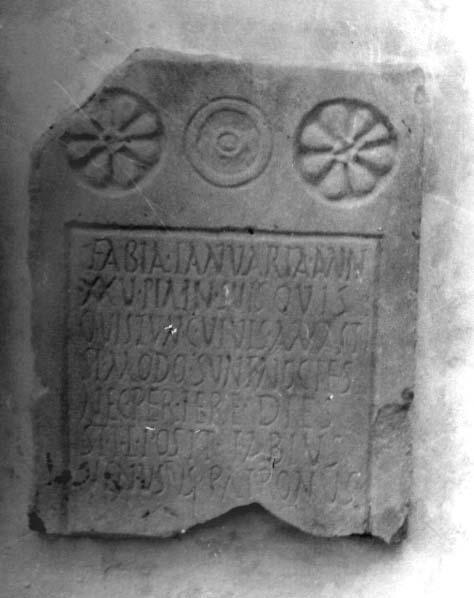Epitaph of Fabia Januaria
Reference CIL II2/5,1118 | Description | Lyrics | Location | Chronology | Epigraphic edition | Translation | Apparatus | Comentary | Type of verse | Text divided into verses and metric signs | Images | Bibliography | Link to DB | Author |
Epitaph of Fabia Januaria
Description
- Idno filename 22/01/0086
- Type of inscription: Sepulcralis
- Material Description: Yellowish color.
- Conservation status: Loss of left-hand upper corner and lower part, without affecting the text.
- Dimensions height/width/depth (cm): 55/44/4.5
-
Epigraphic field:
- Layout: Good "ordinatio". Book script, triangular interpunctions. The guidelines mentioned by the editors cannot be seen in the photograph.
- Decoration: Given the decoration and open epigraphical field it could be a stele. In the upper part, central patera flanked by two flowers with eight petals.
- Preserved
Lyrics
- Font:Libraria
Location
- Place of discovery: Found in Osuna, en la finca “La Dueña Baja” propiedad de D. Juan Fernández, hacia el km. 75 de la carretera de Sevilla (in the country house “La Dueña Baja” property of J. Fernández, towards km. 75 of the road to Seville) Rodríguez Neila. It was acquired by. Domínguez Puerta, in whose private collection González Fernández saw and photographed it in 1978. The same edition and photograph were later published in CIL II2/5,1118.
- Geolocation
- Location with Modern Nomenclature España / Sevilla
- Location with Old Nomenclature Hispania / Baetica / Astigitanus / Hispalis
Chronology
- Inscription's dating: Between year 170 and year 230
- Dating explanation: Rodríguez Neila dated it to between the 2nd and 3rd centuries from the form of the letters, the interpunctions, the lack of a praenomen and the decorative motif of the patera, which he linked to the Dionysian cults. González Fernández CIL II2/5,1118, from paleographic evidence, dated it to the end of the 2nd - beginning of the 3rd c.
Type of verse
- Type of verse: Dactílico (hexámetro)
- Verse/line correspondence: Si
- Prose/verse distinction: Si
Epigraphic edition
Fabia ▴ Ianuaria ▴ ann(orum)
XXV ▴ pia ▴ in ▴ suis quis
quis ▴ tunc ▴ vivis ▴ amasti
si ▴ modo ▴ sunt ▴ noctes
5 nec ▴ periere ▴ dies
s(it) ▴ t(ibi) ▴ t(erra) ▴ l(evis) ▴ posit (!)▴ Fabius
Venustus ▴ patronus
Text divided into verses and metric signs
Quisquis tunc vivis amasti l|l/l|lww|l~
si modo sunt noctes nec periere dies lww|ll|l||lww|lww|~
Translation
Fabia Ianuaria, twenty-five years of age. Loved by her own. So long as there are nights and the days have not perished, then whoever you are, if you are alive, you have loved. May the earth rest lightly on you. Fabius Venustus, her patron, placed this here.
Bibliography
Rodríguez Neila 1976, 371–377 (inde AE 1976, 284 a); González Fernández, CILA II, 644; id. II2/5, 1118; Fernández Martínez – Carande, CLEB SE16, cum im. phot, quae in linguam Hispanicam verterunt; Cugusi 2012, 45. – Cf. Cugusi 2004, 125–172; Cugusi 2004b, 78.
Comentary
Epitaph dedicated by Fabius Venustus to his freedwoman Fabia Ianuaria. Praescriptum in prose with the name and age of the deceased and the formula pia in suis, which is typical in Baetica (particularly in the conventus Cordubensis and the Hispalensis) and appears in the 2nd c. (an indication of date). Address to the passer-by, a well-known motif in epigraphical tradition in verse (Hernández Pérez 2002, 217ff.). The originality in the expression of a maxim on the universality of love has no epigraphical or literary parallels.
The gens Fabia was widespread throughout the peninsula, especially in Baetica (cf. Castillo García 1965, 395). Also common was the cognomen Ianuarius, more so among female slaves and freedwomen (Abascal 1994, 388-389, with 54 examples). The cognomen Venustus, was well documented in Hispania (Abascal 1994, 541 and 542).
The carmen begins at quisquis (l. 2), with the second hemistich of a hexameter from the penthemimer, and continues with a pentameter. The lack of interpunction between suis (end of the praescriptum) and quisquis can be taken as an indication of the beginning of the carmen. The hyperbaton of the adverb tunc (l. 3) can be highlighted, with a usual conclusive value in hypothetical contexts (cf. OLD s.v., 5), predictably for metric reasons. Perfect periere, poetic in contrast with forms in -erunt. Posit x posuit, syncope (cf. Carnoy 1971,113, who records another three examples: CIL II 2698, 2601, 2712).
Author
- Author:C. Fernández Martínez, R. Carande Herrero
- Last Update2024-02-25 19:33:20
You can download this






